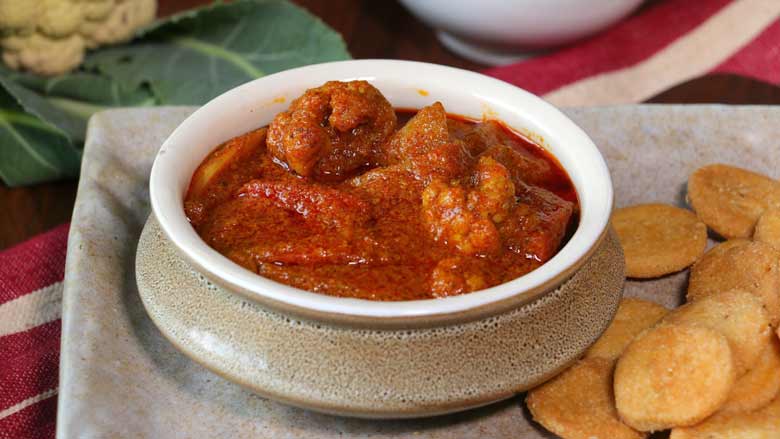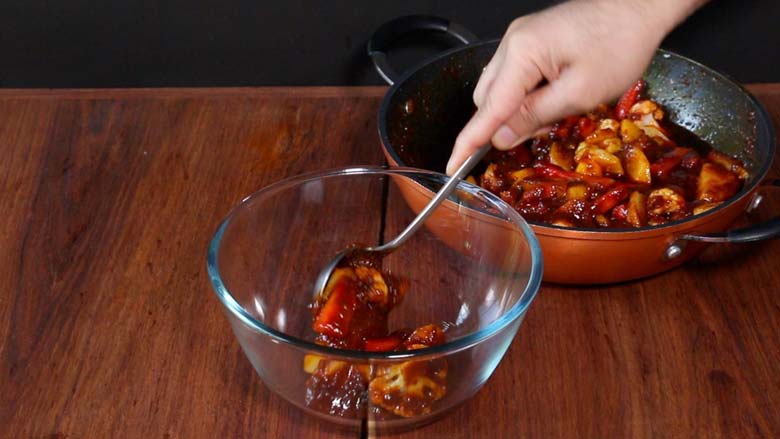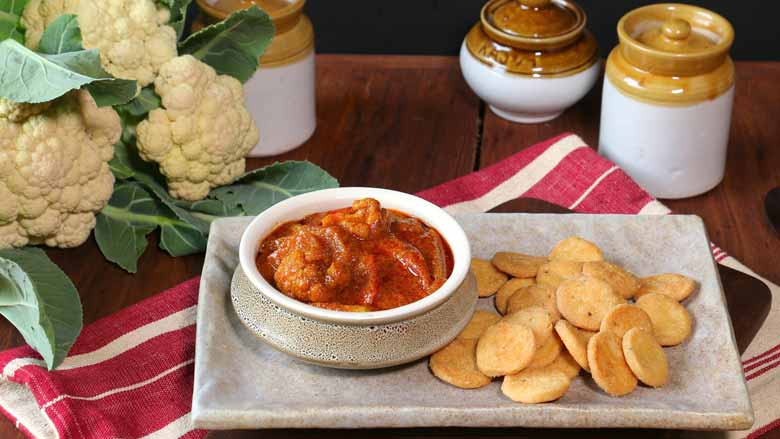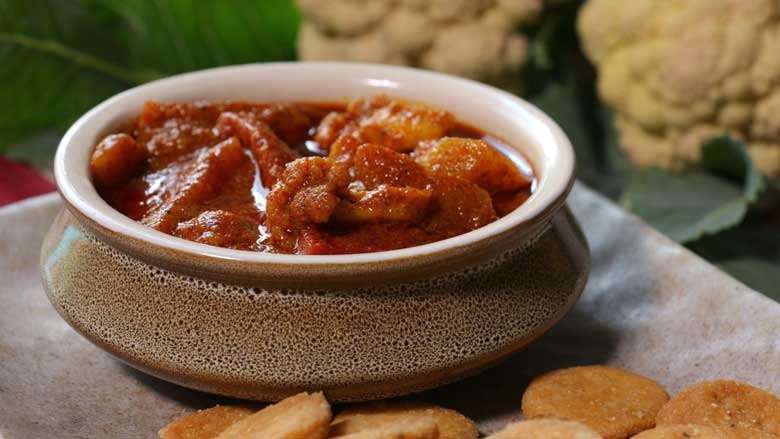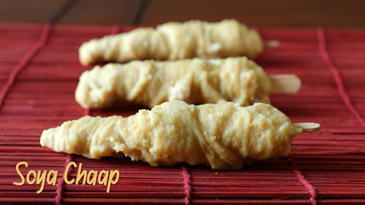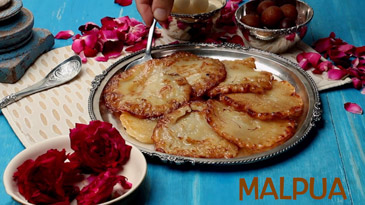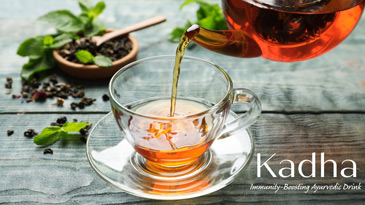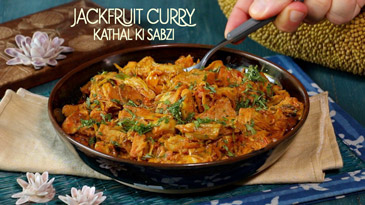Gobi Shalgam Achar Recipe | How To Make Gobi Shalgam Pickle
+Our sweet and sour, perfectly spiced, and delicious seasonal gobi shalgam achar recipe is a Yummefy specialty and is always on hand at home. It has been 50 years since this Punjabi gobi shalgam pickle recipe was shared with my mother-in-law by a close friend; and has been cooked, preserved, made, re-made, and now passed down generations. Every winter during cauliflower season, our easy gobi shalgam pickle is made at home in bulk and then shared with friends and family. If you like sweet, sour, and slightly spicy pickle, you will certainly love this one. We suggest you immediately grab the freshest winter produce (or grow it like us) while it’s still in season and follow this recipe to make the best gobhi shalgam pickle.

Gobi Shalgam Achar ingredients:
The main ingredients for our gobi shalgam achar recipe are farm fresh cauliflower, carrots, and turnips. For the masala powder, you will need cinnamon, black cardamom pods, black peppercorns, nutmeg or jaiphal, cloves, cumin seeds, and mace (javitri). These spices will be dry roasted and ground into a masala powder. Additionally, you need black mustard seeds, white vinegar, jaggery or gur, mustard oil, tamarind, onions, garlic and ginger pastes, turmeric powder, salt, and red chilli powder (preferably Kashmiri degi mirch) to complete the recipe.

You may wonder about the taste profile of this much adored Punjabi gobi shalgam pickle. When the pickle is ready, you will have crunchy cauliflower florets, carrot batons, and turnip disks, in a spicy, sweet and sour masala, which is simply irresistible. The pickle, though an instant one if you don’t count the two days in the sun, gets better and better as it matures.
On a personal note, we have fond memories of the days we would find gobi shalgam achar in our school tiffin boxes. We would also look forward to eating this achar on Sunday brunches and lunches consisting of aloo parathas, yogurt, and a big serving of this delicious pickle on the side. And of course, one cannot forget the quick snack of crisp mathi laden with delicious gobi shalgam achar…heaven!

How to make Gobi Shalgam Achar well:
Before we get on with the expert tips and tricks learnt from our elders, let us share what flavours some of these ingredients bring to this pickle. Vinegar is used as a preservative and lends sourness to our gobi shalgam achar recipe. Ginger, garlic, and onions create a flavourful base for the pickle, while jaggery sweetens as well as mellows the heat of the spices. Mustard oil also acts as a preservative while imparting it’s distinct flavour profile to the pickle with its pungency.

To make the best gobhi shalgam pickle, pick the freshest vegetables you can find in the market, or as mentioned above, grow them at home like us. There is nothing better than picking fresh vegetables from your garden and turning them into a super tasty dish. Fresh vegetables not only ensure a good, clean tasting pickle but are crucial to retain the crunchiness of the pickle as well.

After blanching the vegetables, drying them in the sun for two hours is a mandatory step. It is no secret that moisture causes fungus or mold in the pickles and we certainly do not want that after putting much effort into making it. We are often asked “why do my pickles spoil” or “why does my achar have mold in it” – moisture is the main reason. So dry, dry, dry – do not use any ingredient that still has moisture or water on it if you want mold-free Punjabi Gobi Shalgam pickle.
Working ahead is an option on one step if the recipe – so If you want to reduce some time and workload on the pickle-making day, make the masala powder a night ahead and store in an air-tight container.

While making the jaggery-vinegar syrup (step 4 of the recipe), you can grate jaggery so that it dissolves easily.
Once the gobi shalgam achar is made, use a clean spoon or ladle to transfer it to a stainless steel pateela or a non-reactive bowl (vinegar reacts with some metals hence it is best to avoid those) and cover it with a muslin cloth secured to the bowl. Place the pickle in a sunny area for two days but remember to bring the pickle back indoors during the night so that it doesn't get affected by morning mist / dew, or other critters who might take a liking to your achar.

Pro-tip: Make two-three batches of the pickle to enjoy it all year long or make a big batch by doubling or tripling the quantities suggested in the recipe. If you have a large family, it will disappear before you know it!
How to store Punjabi Gobi Shalgam Pickle:
To store this gobi shalgam achar or any other pickle, you require a martbaan (ceramic pickle jar), a barni, or any glass jar with a non-reactive lid. The pickle keeps well at room temperature in a dark, cool place for up to a year provided you sterilize the jars properly and follow the regular instructions i.e., never keep it uncovered and use only a clean, dry spoon to serve the pickle.

How to sterilize jars for pickling:
Before filling the jars with pickle, prepare the jars by washing them in hot and soapy water. Thereafter, place a clean towel in a large saucepan or another large vessel and place the washed glass jars on the towel. Pour in water to cover the jars, cover the saucepan with a lid, and simmer on medium heat for approximately 10 minutes. Remove and place the glass jars on a clean towel upside down to drain, dry, and cool down. Your jars are now ready to be filled with the lip-smacking pickle you made!

Serving suggestions for our easy gobi shalgam pickle:
Serve pickle with plain parathas, namak-ajwain parathas or with roti and sabzi. It goes very well with just about any meal. Try it with a simple dal and rice preparation to uplift your meal to a whole new level. We also enjoy gobi shalgam achar with makki ki roti and sarson da saag in the winter. And slathered on mathi and eaten with a quick bite anytime.

See our Gobi Shalgam Achar recipe step by step with pictures and video. Learn how to make the best spiced and tasty Gobi Shalgam Achar at home with all ingredients and cooking method right here.
If you liked making our Punjabi Gobi Shalgam Pickle recipe, then do try our:
Gobi Masala | Cauliflower Masala
Chettinad Garlic Pickle
Easy Mango Pickle
Chicken Frankie
Gulab Jamun
Achari Paneer
Ganth Gobi Kashmiri Style
Chicken Biryani
Taar Gosht | Rampur Mutton Curry
10 minute Biryani Masala Powder
Queen of PuddingsIf it is just veggies you want, you can see all our Vegetarian Recipes right here!
Or read more in our article on Traditional Indian Cooking Techniques if you have an interest in learning about Indian cuisine.
-
-
RECIPE
INGREDIENTS
500 grams carrots, cut into batons
1 kilogram turnip, each turnip peeled, cut in half then sliced into ½-inch thick half disks
500 grams cauliflower, cut into 1½-inch florets
Masala Powder:
1 piece cinnamon, 1-inch in length
2 black cardamom pods (badi elaichi)
1⁄2 teaspoon black peppercorns (sabut kali mirch)
1⁄4 whole nutmeg (jaiphal), broken into smaller pieces
10 cloves (laung)
1 teaspoon cumin seeds (jeera)
1 blade mace (javitri), whole
- 3 tablespoons black mustard seeds, (40 grams black mustard seeds)
150 ml white vinegar
200 grams jaggery (gur), broken into smaller pieces
350 ml mustard oil
25 grams tamarind, (about 1 small walnut size piece) soaked in 120 ml water (about ½ cup water). knead with your fingers to make a paste. press through a sieve to remove stringy and tough parts. reserve paste.
200 grams onions, (about 2 medium onions), ground to a paste
3 teaspoons garlic paste, (60 grams garlic)
3 tablespoons ginger paste, (60 grams ginger)
1 teaspoon turmeric powder (haldi)
3 scant tablespoons salt, (60 grams salt) or to taste
2 1⁄2 tablespoons red chilli powder, (25 grams red chilli powder), preferably kashmiri degi mirch
COOKING METHOD
- Blanch vegetables: Place a large saucepan over high heat. Pour in 1½ liters water and bring to a rolling boil. Carefully tip in carrots and blanch for 30 seconds. Use a slotted spoon or spider strainer to remove the carrots from the saucepan and set aside. In the same boiling water, blanch the turnips for 30 seconds, remove, and then blanch the cauliflower for 30 seconds. Spread the blanched vegetables on a large platter or large piece of cloth and leave out in the sun to dry for about 2 hours.
- Make the Masala Powder: Toss the ingredients for the masala powder – cinnamon, black cardamom pods, black peppercorns, nutmeg (jaiphal), cloves (laung), cumin seeds, and mace (javitri) – into a small kadhai or pan over low heat. Stir continuously and dry roast till aromatic. The entire process should not take more than a couple of minutes. Allow the roasted spices to cool, then tip them into a spice grinder or small food processor and run till the spices are ground to a powder. Remove masala powder from the spice grinder and reserve.
- Grind mustard seeds: Place black mustard seeds in the spice grinder and run till powdered. Remove and set aside.
- Make jaggery vinegar syrup: Pour white vinegar into a small saucepan over medium heat. Tip in jaggery (gur) and stir till dissolved, about 2 minutes. Remove from heat.
- Boil Tamarind Paste: Clean and place the same saucepan back on medium heat. Pour in tamarind paste and bring to a boil. Stir for a minute and remove from heat.
- Make the Achar Masala: Place a kadhai or wok over high heat and pour in mustard oil. Heat the mustard oil till it just starts smoking, then reduce the heat to medium and carefully tip in the onion paste. Stir well and fry till golden, about 10 minutes. Add garlic paste and stir frequently till brown, about 11 to 12 minutes. Stir in ginger paste and continue to cook for 2 minutes. Turn the heat off.
- Once off the heat, add tamarind paste, turmeric powder, reserved masala powder, mustard powder, and salt. Stir well before adding the jaggery vinegar syrup, stir again, then add the red chilli powder. Mix till combined well.
- Add blanched vegetables: Gently tip the blanched and dried vegetables into the kadhai or wok with the prepared achar masala. Mix well, ensuring that the masala coats the vegetables well. Transfer the gobi shalgam achar to a non-reactive bowl or pateela and place in the sun, covered, for 2 days. Remember to bring the bowl / pateela indoors in the evening once the sun goes down and then place in the sun once again the next morning.
- After 2 days, transfer the gobi shalgam achar to a large pickle jar or martbaan, or into smaller pickle jars and martbaans, as per your preference. Use a clean spoon to serve the gobi shalgam achar.
- Gobi Shalgam Achar can be stored in a cool, dark place for up to 1 year.
Cook’s Note: How to sterilise jars for pickle: Prepare jars by first washing them in hot soapy water. Then place a clean towel in a large saucepan or other large pot and place the washed glass jars on the towel. Pour in water to cover the jars, cover the saucepan with a lid, and simmer on medium heat for approximately 10 minutes. Remove and place the glass jars on a clean towel upside down to drain and dry. Use immediately once dry and cool.
Recipe Credit: Kapila Kashyap
Yield: 2 kilograms
Serves: 70
Prep Time: 40 minutes plus 2 days unattended time for the achar placed in the sun.
Cook Time: 45 minutes
- Blanch vegetables: Place a large saucepan over high heat. Pour in 1½ liters water and bring to a rolling boil. Carefully tip in carrots and blanch for 30 seconds. Use a slotted spoon or spider strainer to remove the carrots from the saucepan and set aside. In the same boiling water, blanch the turnips for 30 seconds, remove, and then blanch the cauliflower for 30 seconds. Spread the blanched vegetables on a large platter or large piece of cloth and leave out in the sun to dry for about 2 hours.
-
Tags:gobi shalgam achar recipe, how to make gobi shalgam achar, gobi shalgam pickle recipe
-

-
RATE IT:
- ★
- ★
- ★
- ★
- ★
- nah
-






